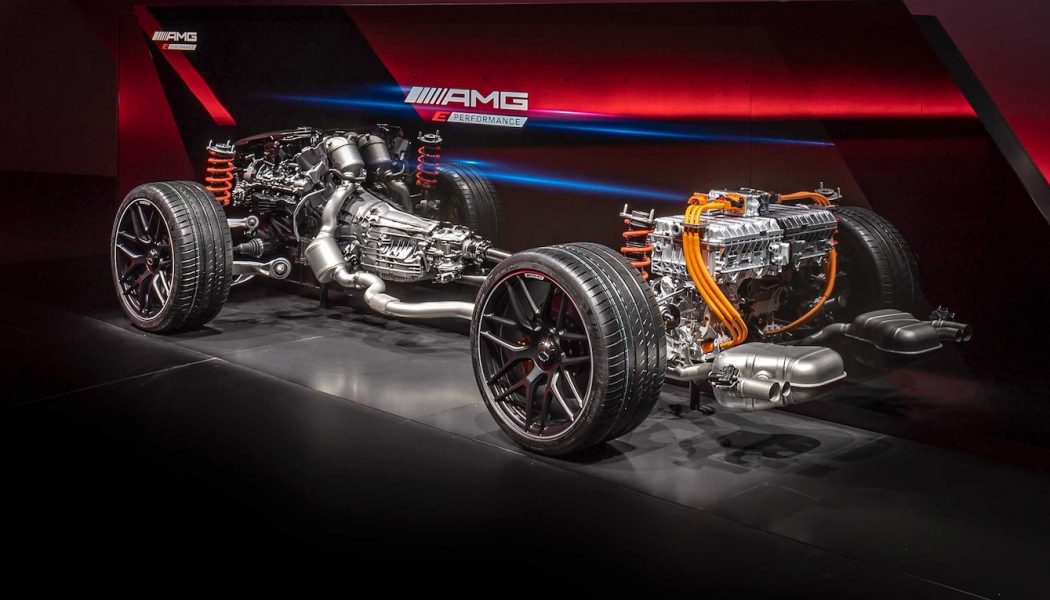The hallmark of performance in the auto industry, increasingly, is electrification. Torquey electric motors, either on their own or assisting a gas engine, have helped push vehicle performance to new heights. So, it is not surprising that Mercedes-AMG, the V-8-lovin’ performance brand of Mercedes-Benz, is pursuing an electrification strategy that includes plug-in hybrids as well as battery-electric vehicles to thrill enthusiasts.
The electrification of the powertrain plays a central role, Philipp Schiemer, chairman of the Board of Management of Mercedes-AMG, says. Future performance hybrids paired with four-cylinder and eight-cylinder gas engines will surpass the driving dynamics of current AMG models, he says, and there will also be battery-electric AMGs based on the Mercedes-EQ brand of electric vehicles.
The plug-in hybrids will use AMG engines with electric motors and a high-performance battery also developed in Affalterbach, as well as the brand’s sportier 4Matic+ all-wheel drive system. It is a modular concept that AMG will roll out across several model series under development.
Big, Torquey Power for Future AMG Hybrids
More than 804 horsepower and 738 lb-ft of torque are possible with the new E-Performance hybrid system. The electric motor provides up to 201 hp and 236 lb-ft of torque, augmenting the output of the respective gasoline engine; we’re guessing the top end of that power range involves a V-8. Depending on the vehicle, the sprint from zero to 60 mph could take less than 3.0 seconds. Executives are not attaching details to specific models yet, nor are they providing range figures.
The automaker describes the coming hybrids as “ambassadors for a new era in the performance segment of the 43 and 53 series AMG models.” In the case of the GT (which could be called the GT73), the performance figures exceed the 630 horses in the current GT63 S. And the newly four-cylinder Mercedes-AMG C-Class hybrid will exceed the output of the current C63.
Deeper Dive Into AMG Hybrid System
AMG’s E-Performance hybrid system uses in-house hardware and software. The layout puts the combustion engine at the front of the vehicle and the Electric Drive Unit on the rear axle. The motor puts torque to the rear wheels but can shift energy to the front wheels on slippery roads.
Putting the AMG-developed electric motor directly on the rear axle instead of locating it between the engine and transmission helps with weight distribution and converts the power more directly into propulsion for an extra boost at launch.
AMG developed its own high -performance battery, inspired by proven and tested technology from Formula 1, with twice the power density of conventional drive batteries, Mercedes-AMG Chief Technical Officer Jochen Hermann says.
Four-Cylinder Hybrid System for Mercedes AMG C-Class
So, about that next-generation AMG C-Class with an E-performance four-cylinder hybrid … Development of the hybrid system has run parallel to work on the eight-cylinder and uses the same basic components. The electric motor is paired with the 2.0-liter turbocharged I-4 which has been used transversely in the subcompact 45 series AMGs. The engine has been reworked and can now be inserted longitudinally which means AMG can use it in the next C-Class with E-Performance, offering a mix of performance and efficiency.
The I-4 is fitted with an electric exhaust turbocharger which comes directly from Formula 1 and is also used in the Project One hypercar. The electric motor is integrated on the shaft of the turbocharger for a rapid buildup of power. The e-turbocharger is small but packs the power of a larger blower.
Output is 442 hp from the engine and another 201 hp from the electric motor which means the next-gen Mercedes-AMG C-Class will have more power than current vehicles with th entry-level V-8 (469 hp, though S models make up to 503 hp). Executives would not say if there is a six-cylinder hybrid system in the works.
V-8 Plug-in Hybrids For AMG
AMG developed a hybrid system to pair with the 4.0-liter twin-turbo V-8 engine and eight-speed transmission positioned at the front of the vehicle. The electric drive unit on the rear axle has a 150-kW motor integrated with an electrically shifted two-speed transmission that shifts into second gear at about 87 mph for optimal use of power.
There is also an electronically controlled rear axle limited slip differential to allocate torque to each rear wheel as needed. The three are combined in a compact unit. It is a layout known as a P3 hybrid and works well for sports cars and performance models. The 400-volt battery is also located in the rear, above the rear axle.
AMG Drive Modes Include “Silent”
Vehicles with the hybrid system have a Silent start mode. When the vehicle is in the Comfort drive mode; the gas engine kicks in at higher speeds. In Electric Drive mode the vehicle will remain in all-electric driving up to 81 mph until the battery is empty. In Sport mode, the vehicle starts with both gas engine and electric motors hard at work; Sport+ provides more boost at launch with a quicker throttle response. Race drive mode is for the track and provides full electric boost power during hard acceleration and strong battery recharging when possible.
Drivers can also choose the level of AMG Dynamics to determine how the vehicle will react, from Basic dynamics with Electric or Comfort drive modes, to Master dynamics in Race mode.
Electric AMGs Will Still Look Like AMGs
Design-wise, the electrified vehicles will continue current AMG characteristics such as the radiator grille with vertical “Panamericana-style” slats, redesigned front bumper, side sill panels, independent rear with spoiler lip and diffuser, AMG wheels, and a sporty interior.
This is an opportunity to redefine the future of automotive performance where hybrids bring dynamics to the next level, Schiemer says.
AMG Will Develop Battery Electric Performance Vehicles
All pure EVs for AMG will use the new Mercedes Vehicle Architecture for luxury and premium vehicles but with extensive modifications to elevate the driving experience and maintain AMG DNA.
The first AMG BEV will be a performance variant of the Mercedes EQS later this year. Not all EQ models will get an AMG variant. Schiemer would not say if there will be EVs in the future on exclusively AMG platforms.
Battery Buildup
The battery storage system was developed in-house, inspired by tech proven in Formula 1 racecars under the toughest conditions. It allows for energy recovery with the ability to shift power in and out of the battery repeatedly. The system can develop power quickly and also recuperate energy quickly while braking.
The cylindrical lithium-ion battery cells were developed with a supplier and there are 560 cells in each battery, providing 70 kW of continuous power and 150 kW of peak power with a cooling pump and heat exchanger to get rid of the heat. The 560 cells are cooled individually, keeping the battery at a consistent 113 degrees Fahrenheit for high-performance capacity at all times. The direct cooling also made it possible to use cells with a high-power density. The battery has 6.1 kWh of capacity, 94 hp continuous power and 201 hp peak power. Power density is 1.7 kW/kg which is twice a conventional battery without direct cooling of the cells.
AMG prioritizes performance over range. Top speed in EV mode is 130 kmh (81 mph). In hybrid mode the powertrain provides electric boost when needed.
Assembly Required
At the engine plant in Affalterbach, AMG is setting up an additional production line for high-performance 4-cylinder engines which will also be used in plug-in hybrids. The line will continue to follow the one-man, one-engine principal.
The automaker is also building a new test center for electrified powertrain components and high-voltage batteries in Affalterbach. It will be complete next year.
Project One Hypercar Deliveries to Start
Deliveries of the exclusive series Mercedes-AMG Project One hypercar start this fall and continue through 2022. There will be 1,275 built in total in a car that adapts a Formula 1 engine for the road.








